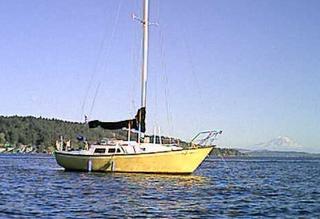 |
 |

"We Were Highballing, So The Hogger Beat 'Er On The Back"
Travel by train is just so civilized, especially if you're lucky enough (as I was on my return trip from Portland) to ride on one of the cross-country routes, in this case the "Coast Starlight". Unlike buses, you're not packed in with dishevelled, sweaty, unsavory looking characters, who've been on the road for several days -- and smell like your laundry basket after you've been camping for a week. And unlike airplanes, you actually have the advantage of being able to see and enjoy the scenery you're passing through.
There's a sense of spaciousness to rail-riding that is absent in just about any other form of long-distance transportation; you can actually get up, walk around, go to the lounge -- or better yet, the dining car for an actual sit down meal, with white linen tablecloths, real silverware, a waiter taking your order. And if you're on a really long trip, you can even spend the night in a private sleeping cubicle. You sure don't get that kind of service on airlines, which except for their convenience of speed have evolved into little more than "buses with wings".
Another thing I like about trains is how they exude an atmosphere of congeniality. Almost everyone you meet on a train -- from the conductor on down to the youngest passenger -- seems genuinely pleased to be there. Maybe it's the novelty of the experience, but they're relaxed, physically loose (perhaps from all that swaying back-and-forth), cheerful and unhurried. Train travel facilitates an opening up of personal space in a way that being packed together like sardines in a plane or on a bus can never come close to matching. You're not forced to interact with the person sitting next to you, but at the same time conversation just seems to come out as a natural consequence of the environment.
Since I usually travel solo, I almost always end up seated in the dining car with other people -- to maximize space -- so I'm invariably put in the position of eating my meal with complete strangers. Yet rather than feeling like an imposition or invasion of privacy, in my limited experience it's quite the opposite; the conversation is always generally pleasant, the food surprisingly good (albeit somewhat on the pricey side), and the service nearly impeccable.
For many people rail travel is something of a treat, a throwback to an earlier era when getting from one place to another could be measured in tens of miles per hour instead of hundreds. Trains move at a speed that can easily be assimilated; there's a sense of human scale to be had in rolling through towns and villages, following the courses of rivers and creeks, skirting the edges of farms, pastures and wilderness, paralleling roads and highways in one continuous ribbon of experience, like a movie that scrolls by on an infinitely long spool.
But, what I find most fascinating about train travel is the brief glimpse it allows into the hidden sides of peoples' lives. There's a good reason why we refer to "the other side of the tracks" as the downscale, the less-than-ideal, the lower class side of things, because in small towns and villages the tracks parallel the main streets, and are literally the dividing line between the carefully maintained storefronts and houses on the front side and the detritus that accumulates behind them: the brackish inflatable swimming pools, encrusted plastic lawn furniture, and broken toys strewn through a thousand back yards; the post-apocalyptic landscapes of abandoned buildings, the rain dissolved carcasses of rusted vehicles, the geriatric leaning of old chicken coops and garden sheds, all the things that we keep hidden from the neighbor's view, but which are unceremoniously on display for the benefit of complete strangers thundering past at 70 mph, on their way to somewhere else.
The only real disadvantage I can see with Amtrak is the general laxity in their scheduling (the railroad conductors' watch, that symbol of late 19th/early 20th century chronological accuracy having been chucked at about the same time that Amtrak was created in the early 1970's). On some trains nowadays they even make a point of displaying computer generated maps showing your position on the route, with a digital clock to let you know how far behind schedule you actually are. It's not unusual for the Starlight, which normally makes a 35 hour one-way trip between Seattle and Los Angeles, to arrive hours late at its end destination
So, I fully expected to depart late from Vancouver, but was pleasantly surprised when the engine rolled up right on-time. I learned later that there had been a tunnel fire between Sacramento and Eugene, and that this train had actually been sent down from Seattle earlier in the day to pick up the unlucky passengers who had to be rerouted around the blockage -- sometimes even with trains you get stuck riding the bus.
Posted byCOMTE
on 10:55 AM
|
 |

